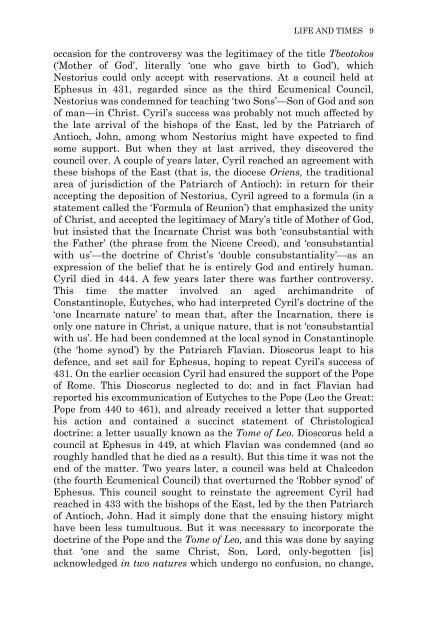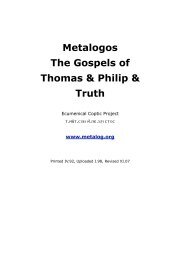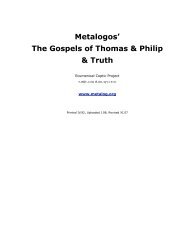Andrew Louth - Syriac Christian Church
Andrew Louth - Syriac Christian Church
Andrew Louth - Syriac Christian Church
You also want an ePaper? Increase the reach of your titles
YUMPU automatically turns print PDFs into web optimized ePapers that Google loves.
LIFE AND TIMES 9<br />
occasion for the controversy was the legitimacy of the title Tbeotokos<br />
(‘Mother of God’, literally ‘one who gave birth to God’), which<br />
Nestorius could only accept with reservations. At a council held at<br />
Ephesus in 431, regarded since as the third Ecumenical Council,<br />
Nestorius was condemned for teaching ‘two Sons’—Son of God and son<br />
of man—in Christ. Cyril’s success was probably not much affected by<br />
the late arrival of the bishops of the East, led by the Patriarch of<br />
Antioch, John, among whom Nestorius might have expected to find<br />
some support. But when they at last arrived, they discovered the<br />
council over. A couple of years later, Cyril reached an agreement with<br />
these bishops of the East (that is, the diocese Oriens, the traditional<br />
area of jurisdiction of the Patriarch of Antioch): in return for their<br />
accepting the deposition of Nestorius, Cyril agreed to a formula (in a<br />
statement called the ‘Formula of Reunion’) that emphasized the unity<br />
of Christ, and accepted the legitimacy of Mary’s title of Mother of God,<br />
but insisted that the Incarnate Christ was both ‘consubstantial with<br />
the Father’ (the phrase from the Nicene Creed), and ‘consubstantial<br />
with us’—the doctrine of Christ’s ‘double consubstantiality’—as an<br />
expression of the belief that he is entirely God and entirely human.<br />
Cyril died in 444. A few years later there was further controversy.<br />
This time the matter involved an aged archimandrite of<br />
Constantinople, Eutyches, who had interpreted Cyril’s doctrine of the<br />
‘one Incarnate nature’ to mean that, after the Incarnation, there is<br />
only one nature in Christ, a unique nature, that is not ‘consubstantial<br />
with us’. He had been condemned at the local synod in Constantinople<br />
(the ‘home synod’) by the Patriarch Flavian. Dioscorus leapt to his<br />
defence, and set sail for Ephesus, hoping to repeat Cyril’s success of<br />
431. On the earlier occasion Cyril had ensured the support of the Pope<br />
of Rome. This Dioscorus neglected to do: and in fact Flavian had<br />
reported his excommunication of Eutyches to the Pope (Leo the Great:<br />
Pope from 440 to 461), and already received a letter that supported<br />
his action and contained a succinct statement of Christological<br />
doctrine: a letter usually known as the Tome of Leo. Dioscorus held a<br />
council at Ephesus in 449, at which Flavian was condemned (and so<br />
roughly handled that he died as a result). But this time it was not the<br />
end of the matter. Two years later, a council was held at Chalcedon<br />
(the fourth Ecumenical Council) that overturned the ‘Robber synod’ of<br />
Ephesus. This council sought to reinstate the agreement Cyril had<br />
reached in 433 with the bishops of the East, led by the then Patriarch<br />
of Antioch, John. Had it simply done that the ensuing history might<br />
have been less tumultuous. But it was necessary to incorporate the<br />
doctrine of the Pope and the Tome of Leo, and this was done by saying<br />
that ‘one and the same Christ, Son, Lord, only-begotten [is]<br />
acknowledged in two natures which undergo no confusion, no change,




